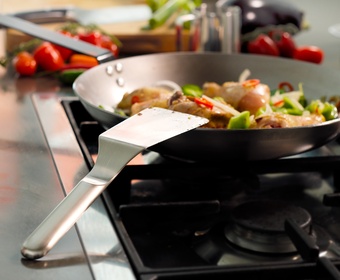About spatulas
What makes a perfect, professional quality spatula? Nothing beats stainless steel which is both strong, flexible, heat resistant, and can be molded into almost any shape. But technique (which, in turn, takes paractice) is also crucial. A seasoned chef really knows how to flip a burger, sliced eggplant, or a fried egg!
No, only a spatula will do.
– Chef Carina Brydling will consider no other tool for frying
Only steel will do
A spatula doesn’t look like much, but this humble tool must have lots of qualities to do its job properly. Durable, strong, but still springy; steel is the only material that meets all requirements.
Both steady and flexible
This is the balancing act: The blade has to be thin enough to slip in under a fried egg, but remain firm enough to support a sizeable steak.
The right technique
Studying pros in the kitchen is revealing: Most chefs use an “at a slight angle from the side” manoeuver to pick up tender morsels of food from the frying surface.
Plastic is a no-no
Heat-resistant silicone plastic is flexible, but even the thinnest possible design is too blunt for a spatula. A wobbly spatula is irritating at best, a potential hazard in the kitchen at worst. And hot plastic does not belong in food.
Teflon is a no-no
Pans with Teflon and other non-stick surfaces should not be in a professional kitchen. They can’t take the heat, nor can they take a steel spatula.
Why fry?
- When proteins and carbohydrates react on the browned surface, they create lots of amazing flavors. The food looks more appetizing too.
- The fat in the pan not only stops the food from sticking, but it also improves the taste. Fat is a carrier of flavor.
- With a short burst of intensive and superficial heat you can cook food – for example, meat – to a tasty, crispy exterior with a soft, juicy center.
Fry for flavor
Frying creates new aromas and flavors on the surface of food as proteins and carbohydrates react forming tasty molecules in hundreds of combinations. This is known as the Maillard effect.
140 to 160°C
The temperature must be above the boiling point for the food to “brown”. Between 140 and 160°C is a suitable temperature. Go out hard and diminish if/when you have to.
The pro flip
Seasoned professionals introduce the spatula slightly from the side when separating food from a hot surface. A proper spatula has rounded edges to suit this technique.
Oil and butter
Oil can take more heat, but butter tells you how hot the pan is. Using both is a good idea – and the oil goes in first.
The art of not
Frying is sometimes a matter of not doing anything. Be patient. Let the food fry in peace. When it has browned, it will be easier to handle with the spatula.
Frying is mathematics
Think about the power of two: Twice as thick takes about four times as long to cook. Sort your food according to size, like a pro.
ABC of frying
- Let the pan heat up before starting. Don’t be afraid of high temperatures.
- Also, let frying fat heat up before starting.
- For the desired result, always dry food before it goes in the pan.
- Don’t try to fry too much at a time. This will cool down the pan rather than heat up the food.
- Patience. Give the food a little time to brown on the surface and come unstuck.
- Put some money into a proper steel spatula and kitchen tweezers.
Caring for your spatula
- Preferably hand wash with hot water and washing-up liquid.
- A stainless steel spatula can take repeated machine washing, but abrasive materials in some dishwasher detergents will dull the surface of the material. This will not affect its qualities.
- Always dry a spatula when not in use.
- A clean and dry spatula is a better spatula.



